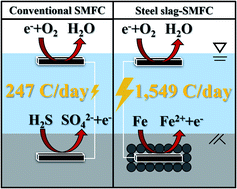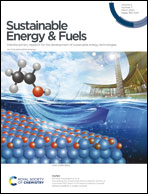Enhanced power performance of an in situ sediment microbial fuel cell with steel-slag as the redox catalyst: I. electricity generation
Abstract
Steel-slag was added as a catalytic material of redox reaction to sediment microbial fuel cells (SMFCs) in an in situ sediment biodegradation experiment to determine its benefits in the long-term power production of the cells and to elucidate the external factors affecting power production. The steel-slag was found to consistently increase the power generated, and over a period of two years, the combination produced six times more charge than that of an SMFC alone (1549 C per day), which was superior to that of conventional SMFCs reported in the literature. After two years of electron-harvesting, the redox potential of pore water rose to the level at which hydrogen sulfide and ammonia can be oxidized. Upon investigation, rapid changes or fluctuations in power production were found to be cathode-related, for example, if it was damaged, or variations in the ambient environmental conditions, such as dissolved oxygen, algal activity, etc., affected its performance. In particular, algal activity appeared within nine days, which led to a 68% increase in the average current density during the day vs. the night.



 Please wait while we load your content...
Please wait while we load your content...